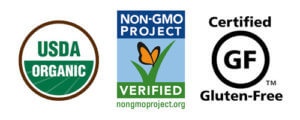What’s interesting about these crackers (pictured on the right) is that they include pretty much the quintfecta of niche, specific, mostly-unregulated, marketing terms: Organic, gluten free, ‘no soy!’, Non GMO Project Verified, and circled U – controlled by the Union of Orthodox Jewish Congregations of America. What do all these badging symbols really mean?
Organic: Okay, so debates rage on about the nature of the term ‘organic,’ and it refers to certain agricultural practices; to an educated scientist, it simply means that it contains carbon – as does everything that’s alive. As American Dietetic Association spokeswoman Keecha Harris, DrPH, observes, “There is no evidence that organic foods are superior over traditional foods.” That conclusion has been confirmed by numerous independent studies, most recently by a team from Stanford University.
Gluten free: This label means that this product (or those similarly-labeled) contains very (very) little gluten. Gluten is a grain protein found in barley, wheat, rye, triticale, etc. There are many food choices that can still be part of a gluten-free diet; some are listed here. New regulation defines the term ‘gluten free’ to be those products with fewer than 20 parts-per-million (ppm) gluten. Originally, a diet excluding gluten was designed to reduce symptoms of celiac disease, which affects about 0.5 percent (half-percent) of the United States population. Now this protein avoidance is used by marketers suggesting that many people suffer from non-celiac gluten sensitivity and wheat allergies. However, there have been no well-designed randomized controlled experimental trials demonstrating that a gluten-free diet provides any benefit for the general majority of the population who do not suffer from celiac disease or allergies to wheat.
Soy free: About 0.4 percent (less than half-percent) of the population of children in the United States have soy allergy. The immune system determines certain components of soy protein to be foreign, and so generates immunoglobulin E (IgE). Symptoms range from hives and itching around or in the mouth to anaphylaxis, which could be fatal if untreated. The Allergy and Asthma Foundation of America includes soy as one of the most common food-based allergens.
Non-GMO Project: Strangely un-hyphenated on their labels since it should be a hyphenated term, its literature states, “The Non-GMO Project is a non-profit organization committed to preserving and building sources of non-GMO products, educating consumers, and providing verified non-GMO choices.” Upwards of 80 percent of the corn used in the United States has been genetically-modified. It can be somewhat easier to find rice and other gluten-free specialty grains for snacks such as these which are non-GMO.
Kosher certified: The Orthodox Union certifies an enormous number of food products each year for consumption. According to its data, upward of 60 percent of the kosher certified foods in the United States have this logo—an annual market estimated at $150 billion. Interestingly, even outside of the religious requirements for those who choose to eat kosher, the certification is done for ostensibly marketing reasons to increase sales:

So who are these products marketed for?
If we assume that each of these certifications are independent probabilistic groups, and that there aren’t more people with celiac disease who have soy allergies (this cross-reactivity has not been reliably demonstrated), then we can determine the actual number of people who would want a product with all of these characteristics:
.02 (kosher) x .005 (celiac) x .004 (soy allergy) = .0000004, or .00004 percent of the U.S. population – or about 125 people – who would fit into the category of needing such a broad-spectrum, multi-badged snack with full specificity; The number becomes even fewer if we were to estimate for whom ‘Non-GMO Project’ and ‘organic’ are also requirements, though there is likely to be considerable overlap across choosers of those terms for marketing purposes.
On the other hand, with so many kosher-certified products on store shelves labeled with the ‘circled-U’ their number far exceeds the 2 percent of the population for whom they are targeting. This truly represents a marketing Pareto relationship: a small proportion of the ‘cause’ represents a large quantity of the ‘effect.’ [You may have heard this called the ‘80/20 rule,’ in which a large majority of effects (‘80’) is caused by a small number of causes. For example, a small proportion of the US (and world for that matter) population account for the vast majority of the wealth. ]And really, we know that the marketing folks added the badges, not for dependent probabilistic groups, but for independent choosers who may be enticed by any of the myriad badges on the packaging. Consumer behavior is incredibly malleable.
Ben Locwin, PhD, MBA is a contributor to the Genetic Literacy Project and is an author of a wide variety of scientific articles for books and magazines. He is also a researcher and consultant for a variety of industries including behavioral and psychological, food and nutrition, and pharmaceutical. Follow him on Twitter @BenLocwin.































